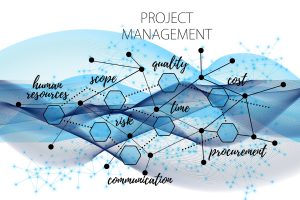
The Organizational Project Management Offices (PMOs) has emerged as critical players in driving successful digital transformation. Much more than just keeping projects on track, the modern PMO is a central force in shaping how organizations embrace new technologies, manage change, and adapt processes for the future.
The PMO as a Transformation Leader
Traditionally, the PMO’s role was to ensure project governance, align objectives with business strategies, and manage resources effectively. However, in the context of digital transformation, the PMO has evolved into a strategic leader, tasked with guiding organizations through fundamental changes. The ability to manage both the technological aspects and the human impact of these transformations is where the PMO truly shines.
Why Close Collaboration with the C-Suite is Critical
The collaboration between the PMO and the C-Suite has never been more critical due to the extremely competitive business environment. Digital transformation has evolved from isolated technical upgrades to comprehensive strategic initiatives that shape an organization’s future. As such, PMOs must work closely with the C-Suite to ensure that transformation efforts are tightly aligned with overarching business goals.
- Ensuring Strategic AlignmentDigital transformation initiatives can easily drift off course if they are not aligned with the organization’s strategic objectives. By working closely with the C-Suite, the PMO ensures that projects contribute directly to the long-term vision of the company. Regular communication with executive leaders helps the PMO understand shifting priorities and adjust project roadmaps accordingly. This alignment is key to driving initiatives that offer real value and competitive advantage.
- Driving Business OutcomesC-Suite leaders are increasingly focused on business outcomes rather than just project milestones. The PMO’s close collaboration with executives ensures that every transformation effort is focused on driving measurable business results, whether that’s increasing market share, improving customer experiences, or streamlining operations. By keeping strategic objectives at the forefront, the PMO can steer projects to deliver tangible, high-impact results.
- Breaking Down Organizational SilosPMOs working closely with the C-Suite can help break down departmental silos that often hinder digital transformation. By facilitating collaboration between departments, the PMO ensures that every part of the organization is moving in the same direction. This top-down alignment fosters a more unified approach, enabling smoother cross-functional cooperation and minimizing internal resistance to change.
- Anticipating Risks and OpportunitiesThe C-Suite provides the PMO with a broader view of the market, industry trends, and potential risks or opportunities. This insight allows the PMO to anticipate changes in the business environment and proactively adjust project scopes or strategies. A close relationship with executive leadership enables the PMO to be more agile in addressing unforeseen challenges, ensuring that projects remain resilient and adaptable.
Strategies for Managing Change in Digital Transformation
- Define Clear ObjectivesA digital transformation is more than a technology upgrade. PMOs must work closely with stakeholders to clarify the vision, aligning it with the company’s overall strategy. Understanding and communicating the “why” behind the transformation helps set clear goals and enables teams to align and move in the same direction.
- Prioritize Change ManagementSuccessful digital transformation is as much about people as it is about technology. PMOs need to focus on change management by preparing the workforce for new processes, roles, and responsibilities. This means conducting regular training, offering support, and communicating frequently to reduce uncertainty.
- Engage Stakeholders EarlyResistance to change often stems from a lack of involvement or understanding. Engaging key stakeholders from the outset helps mitigate this. When employees feel they have a voice and can contribute to the decision-making process, they are more likely to embrace the changes.
- Adopt an Agile MindsetDigital transformation is rarely linear. PMOs must adopt an agile approach, enabling rapid iteration, flexibility, and a fail-fast, learn-fast mentality. This helps the organization to stay resilient and adaptive in the face of technological disruption.
Overcoming Resistance to Digital Transformation
Resistance to change is natural and human, but it can be detrimental to digital transformation initiatives. The PMO must address resistance proactively by:
- Fostering a Culture of InnovationEncourage teams to see change as an opportunity rather than a threat. PMOs can do this by celebrating small wins, recognizing innovators, and creating an environment where experimentation is encouraged.
- Tailoring CommunicationDifferent teams and individuals react differently to change. The PMO should craft customized communication strategies that resonate with various groups within the organization, focusing on how digital transformation benefits their specific roles and contributions.
- Providing Ongoing SupportResistance often comes from fear of the unknown or skill gaps. Offering continual training, access to new tools, and leadership support and clear communication throughout the transformation journey helps reduce fear and build confidence.
Ensuring Successful Adoption of New Technologies and Processes
One of the critical roles of the PMO is ensuring that new technologies and processes are not only adopted but fully integrated into the organizational fabric. This requires:
- Continuous Monitoring and Feedback LoopsPMOs should establish mechanisms for continuous monitoring of technology implementation and process changes. Gathering feedback, adjusting strategies, and addressing challenges in real-time ensures that transformation efforts stay on course.
- Aligning IT with Business GoalsDigital tools and processes should not be adopted for their own sake. The PMO must ensure that any new technology is tightly aligned with the organization’s overall goals, enhancing efficiency, productivity, and customer satisfaction.
- Building Long-term CapabilitiesPMOs should focus on building long-term capabilities rather than one-time solutions. This involves investing in skill development, fostering cross-functional collaboration, and encouraging a learning culture that keeps pace with technological advancements.
The PMO’s Strategic Role
The PMO’s role in digital transformation is pivotal. By guiding organizations through change, managing resistance, and ensuring seamless adoption of new technologies, the PMO becomes a linchpin for future-ready organizations. Success lies not only in technical prowess but in understanding and navigating the human side of transformation, ensuring that change is embraced at every level of the organization.
Interested in learning more about how your PMO can become a driver of successful digital transformation? Get in touch so we can discuss strategies for empowering your team to lead with confidence in the digital age.

